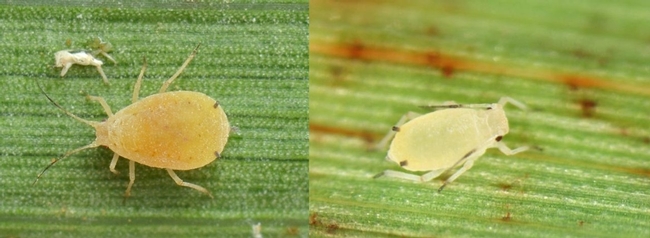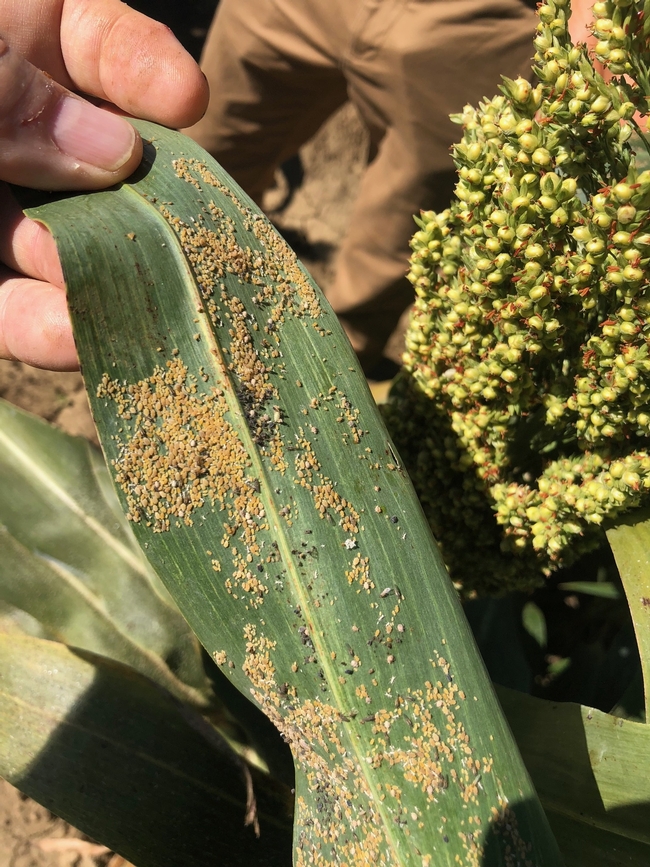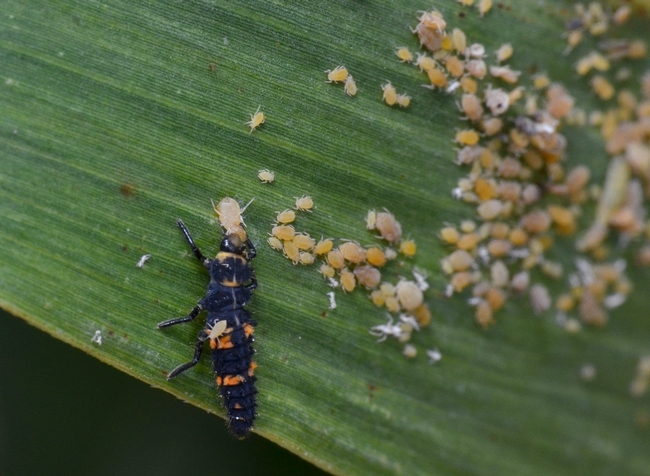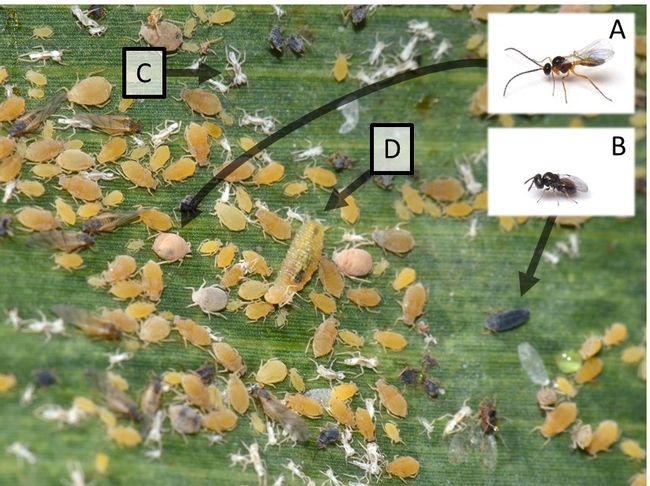Sorghum is grown in California as a high yielding, drought resistant, low input forage and grain crop.
However, it's been bugged lately.
Last month, a sorghum field in Yolo County and fields throughout the Central Valley were infested with sugarcane aphid. This infestation came in relatively late in the Sacramento Valley.
The sugarcane aphid has a characteristic combination of black marks on its legs and antennae, plus black cornicles. (Photo Ian Grettenberger, left, Texas A&M, right)
This insect infestation isn't as severe as three years ago, when this pest burst with a vengeance upon California sorghum fields, having first troubled plantings in Texas and Oklahoma, where large acreages are grown. Unfortunately, it has made a regular appearance in California for the last three sorghum seasons.
How to ID? This aphid is best identified by its light-yellowish color (although color can vary from yellow to tan to gray), and, using a hand lens, black-tipped antennae, black feet, and black cornicles (rear tailpipes). The infestation in this particular Yolo County field came late, within a few weeks of harvest, so damage will likely be minimal. Early infestations can cause significant losses in both yield and quality in grain and forage sorghum. Likewise, heavy late infestations with lots of sticky honeydew can cause problems with grain harvests.
Natural enemies, including both wasp parasitoids and generalist predators like lady beetles, can help reduce populations, but not always enough to prevent damage (see photos below).
For identification, scouting, and treatment thresholds, see Blog: Be alert for Sugarcane Aphids by Nick Clark.
Origin:The sugarcane aphid on sorghum has a long history in Asia, Australia, Africa, and South America (Brazil). In 2013 the sugarcane aphid was first reported on sorghum primarily in Texas and Louisiana, as well as Mexico. Many entomologists believe the aphid moved from Brazil through Mexico and into Texas and Louisiana, riding on wind currents, a very common way for insects to disperse. This is likely how it first arrived in California in the Imperial and then San Joaquin Valley in a sorghum field in 2016, and then here in the Sacramento Valley.
Host range and dispersal: Sugarcane aphid has a very narrow host range and is restricted to plants in the genus Sorghum, including Sudangrass and Johnsongrass. The sugarcane aphid on sorghum will not colonize sugarcane. This aphid is semi-tropical and must have a living host to overwinter and is well-known to survive during the winter on Johnsongrass and remnant sorghum in south Texas. There are some reports of the sugarcane aphid overwintering in areas farther north into the High Plains of Kansas. This may be true if the aphid finds very protected areas where Johnsongrass will not dieback during periods of very dry conditions.
Best Management Practices to control sugarcane aphid
- Control Johnsongrass, volunteer sorghum, and other sorghum species in and around your fields during the winter and spring prior to planting.
- Consider planting a hybrid that has shown tolerance to the aphid.
- Plant seeds treated with a neonicotinoid - such as imidacloprid or clothianidin-insecticide seed treatment.
- Plant early (sugarcane aphids tend to infest fields later in the season).
- Scout fields early and often to evaluate the aphid infestation level
- If controls are needed, it is preferred to apply an aphid-specific treatment (e.g. flupyradifurone (Sivanto)) in a water volume high enough for good foliar coverage when 25% of the plants are infested with an average of 50 aphids per leaf (sampling the bottom most, green leaf with at least 90% green tissue, and the leaf below the flag leaf). FOLLOW ALL LABELS and consult UC-IPM site for information on pesticides.
- If aphids are present on upper leaves or grain panicle in sufficient numbers to produce honeydew, consider applying an insecticide to prevent potential harvest problems.
- Conserve beneficial insects such as ladybeetles and parasitoid (parasitic) wasps that prey on sugarcane aphids by using economic threshold levels and avoiding use of insecticides that are harsh on natural enemies (e.g. pyrethroids).
More information on monitoring sugarcane aphid along with information on resistance varieties can be found on the Sorghum website.
Additional resources on identifying and sampling sugarcane aphids can be found from the Texas A&M Department of Entomology on a Sugarcane Aphid Video and a handout on Scouting Sugarcane Aphids.
Sugarcane aphid on sorghum grown in Davis, CA. The underside of the leaves can be loaded with hundreds or thousands of these sucking insects. Treatment thresholds will depend upon time to harvest, aphid numbers, and numbers of leaves affected.(D. Putnam, photo)
A generalist predator, a lady beetle larvae, eating an adult sugarcane aphid. A number of generalist natural enemies, including lady beetle larvae and adults, lacewing larvae, and hover fly larvae will eat sugarcane aphids. (I. Grettenberger, photo)
Photo showing aphid mummies created by parasitoid wasps. The tan/pink-colored and ballooned aphids have been killed by one type of wasp (A, family: Braconidae). The less-swollen black mummy was killed by a different type of wasp (B, family: Aphelinidae). Wasp larvae develop inside the aphids, killing them, and then adult wasps chew a hole in the mummy and emerge. The small white insect-looking things (C) are exoskeletons left over from when the aphids molted (not to be counted when scouting!).The green maggot in the middle (D) is a hover fly larvae and is feeding on an aphid. (I. Grettenberger, photo).



